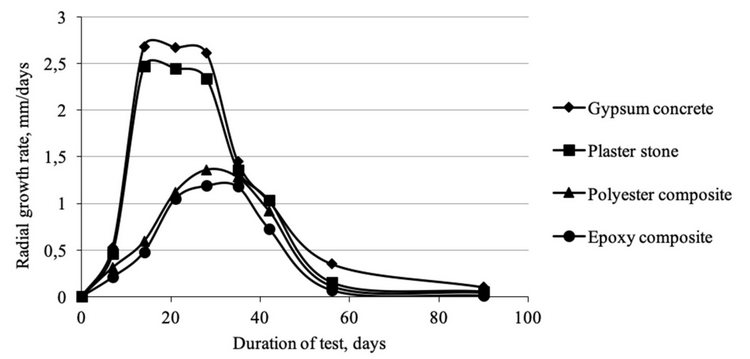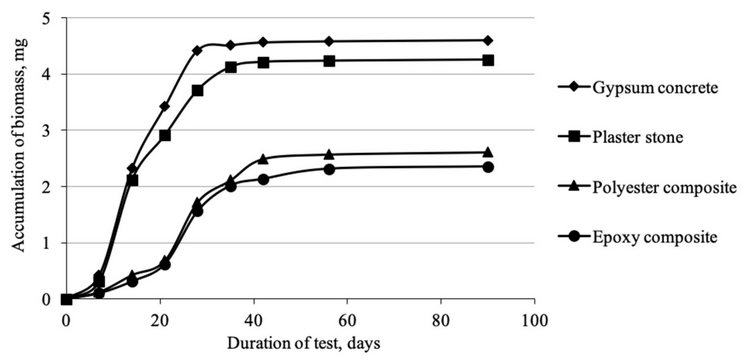In search of optimal construction materials
Professor of the SPbGASU Department of Technology of Construction Materials and Metrology Larisa Yu. Matveyeva, Dr. of Engineering, is engaged in the research related to the problem of preservation of buildings, structures and monuments. Their safety in an urban environment can be influenced by various factors, such as car exhaust, high air humidity, sudden changes in temperature and mold fungi that multiply in moist air, and micromycetes. The problem of protecting architectural masterpieces, ordinary houses in the historical center of St. Petersburg and modern buildings from mold fungi is especially acute.
In December 2019, in the Materials Science and Engineering journal an article by L. Yu. Matveeva, V.M. Pakhtonov, and Yu.M. Tikhonov entitled “Study of micromycete destructive power in gypsum and polymeric binding composite construction materials” was published; it was dedicated to the outcomes of these scientific research.
Larisa Yuryevna answered several questions.
– What determines the relevance of research on this issue?
– It is known that the operation of building structures in conditions of high humidity is accompanied by corrosion damage and destruction, not only under the influence of environmental factors (unstable temperature, humidity, chemically aggressive gases), but also as a result of exposure to living organisms. Organisms that cause microbiological corrosion include bacteria, molds, and microscopic algae. But, nevertheless, the leading role in the bio deterioration processes of building materials of various chemical natures, operated in conditions of high humidity, belongs precisely to mold fungi, the micromycetes.
Micromycetes are natural biodestructors. They have such a “job”: to destroy all kinds of materials, translate them into simple compounds and return to the cycle of matter, thereby ensuring sustainability of the ecosystem.
And for the successful implementation of this work, nature endowed them with specific features: the rapid growth of cells - mycelium, the power and lability of the enzymatic apparatus.
Micromycetes emit a large number of various substances - organic acids and protein enzymes - into the environment on which they settle (substrate).
As a result of vital activity and growth of micromycetes on the surface of building structures, all kinds of damage and defects appear, physical, mechanical and operational characteristics decline (strength, adhesion between components, etc.).
✔ The massive development of molds can cause pulmonary diseases, since among molds there are species that are dangerous to humans.
Therefore, these studies are relevant and important, especially in humid climates and polluted urban air.
– Why are your scientific interests related specifically to composite materials?
– Currently, a number of composite materials based on gypsum, polymer and mixed binders are used in construction for the exterior and interior decoration of buildings and premises. They all consist of two main structural components: a binder and fillers. Therefore, it was of interest to determine the fungi resistance of gypsum and popular organic polymer binders and building composites based on them.
Cement stone and alkaline cement concrete are less susceptible to bio corrosion, as molds “prefer” an acidic or neutral environment, which they themselves acidify. Alkaline environment is less suitable for micromycetes life.
Nevertheless, using the natural capabilities of living organisms, they also “solve” this problem of turning all the materials that people create into simple substances.
– What research methods did you use?
– Fungus resistance and fungicide (ability to suppress the growth of molds) of materials was determined in accordance with GOST 9.048–89 named “Unified system of protection against corrosion and aging. Technical products. Laboratory test methods for resistance to mold fungi." This is a standard technique comprised in GOST 9.049–91 named “Unified system of protection against corrosion and aging. Polymer materials and their components. Laboratory test methods for resistance to mold fungi." It is used abroad and is known as the Unified system of corrosion.
Samples, i.e., pieces of building materials with dimensions of 3 × 3 cm2, were infected with a mixed spore suspension of the most common mold fungi of the Aspergillus, Alternaria, Paecilomyces, Penicillium, Trichoderma genera and kept in an incubator at a temperature of 28 ± 2ºС.
The final assessment of fungus resistance (ability to resist the growth of molds) and fungicide (ability to suppress the growth of molds) of material samples was carried out on day 28; samples were also examined in between and the growth rate of colonies, biomass accumulation, sporulation was evaluated.
– What were the most important and interesting results?
– As we expected, the analysis of the fungi resistance of the samples showed that materials based on gypsum and polymer composites were inferior in fungi resistance to building materials based on cement and, therefore, need to be protected from bio corrosion in conditions of high humidity. Therefore, further research is needed to develop measures to increase their fungi resistance.
✔ New scientific data on the features of the development of molds on building materials were also obtained.
So, for example, it was found that the radial growth rate of mold colonies varies non-linearly. In the initial period (1–7 days), the growth rate of micromycete colonies on the surface of the samples is low. This period, apparently, is associated with the adaptation and coaptation of micromycetes to atypical living conditions, during which the production of the resultant organic acids and enzymes is being mobilized.
In micromycetes developing on the surface of samples of polymer composites, the adaptation period is much longer and averages 14 days. For them, this is a “new and unknown” material for some time, to which they can adapt over time.
{gallery name="Микромицеты интервью Матвеева 012020"}
On days 7–14 from the start of the experiment, a significant increase in the growth rate of colonies on the surface of gypsum stone and gypsum concrete was observed, which is probably associated with the exponential growth phase of micromycetes mycelium and their accumulation of biomass. And on the surface of samples of polymer composites, the phase of exponential growth of micromycetes was noticed later, i.e., on days 14-21. The stabilization phase of the growth rate of micromycete colonies was observed on samples of gypsum concrete and gypsum stone on days 10–14 and on samples of polymer composites on days 21–23. On the 22-30th day, the stationary phase sets in, no increase in the colony growth rate is observed during this period; however, intensive sporulation is noticeable. On the 30–58th day from the beginning of the experiment, a sharp decrease in growth processes occurs, accompanied by intense spore formation and subsequent death of part of the mycelium. Then the cycle repeats again.
The intensive growth and development of colonies of molds is accompanied by the synthesis of a significant number of metabolites, i.e., substances that secrete molds. In molds developing on the surface of gypsum concrete and gypsum stone, acid production predominates, while in micromycetes growing on the surface of polymer samples, it is enzymatic.
The active growth of molds on the surface of polymer composite building materials contributes to the accumulation of enzymatic metabolites that stimulate oxidative and destructive processes in polymer materials and cause a change in their chemical composition.
To study the growth and activity of living organisms is exciting. Often, quite unexpected results may appear, since it is not always possible to predict the response of nature to human activity.
– Will this work be continued in the future?
– It is advisable to devote future studies to assessing the depth of penetration of metabolites into the structure of materials and analyzing changes in micromycetes during the growth of colonies in order to develop effective protective measures to increase the fungi resistance of gypsum and polymer materials and composites.
Studies of fungi resistance and the effectiveness of measures being developed to protect historic buildings, architectural monuments and modern buildings from biodeterioration are very popular in cities with a humid climate, such as St. Petersburg.
Text: Elena Shulgina
✔ Learn more about the studies at the Department of Technology of Construction Materials and Metrology, its teachers and courses



